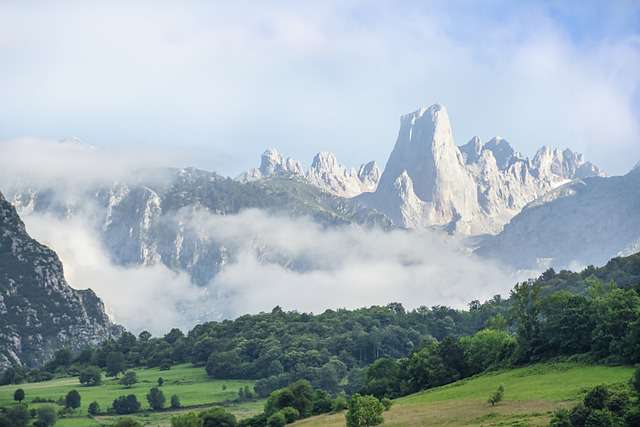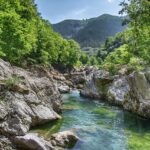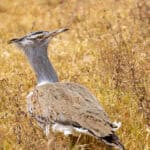Natural vegetation and wildlife represent nature’s beauty and diversity and are essential to our planet’s ecosystem. Wildlife and vegetation consist of a wide variety of plant and animal species.
These plants and animals contribute in different ways to maintaining ecological balance and sustaining life on Earth.
Natural vegetation, from dense forests to vast grasslands, provides habitat for numerous organisms and offers vital environmental benefits such as oxygen production, carbon sequestration, and soil conservation.
Similarly, wildlife represents the intricate web of life, with each species contributing to ecosystem functionality and biodiversity. However, these invaluable resources face numerous threats, including habitat destruction, climate change, and pollution.
Understanding and protecting vegetation and wildlife is necessary to promote a balance between humans and nature, ensuring a sustainable future for everyone.
What is Natural Vegetation and Wildlife?
Natural vegetation refers to plant life that grows without human interference or cultivation in a particular region or ecosystem.
It is composed of plant species that have adapted to the environmental conditions of their specific habitat over time.
Natural vegetation refers to the plant life that grows and flourishes in a specific region without human intervention. Natural vegetation includes various kinds of plants, trees, shrubs, grasses, and other vegetation that naturally grow in an ecosystem.
The types of plants that can flourish in a particular place are often influenced by elements including climate, soil characteristics, and geographic position, which affect natural vegetation.
These plant communities are self-sufficient and maintain a delicate balance with their surroundings, adapting to the environment’s dynamics.
Wildlife
Wildlife is defined as several different animal species inhabiting different ecosystems. It includes mammals, birds, reptiles, amphibians, fish, and other creatures living in their natural habitats.
To maintain the balance and ecosystem biodiversity, wildlife plays a vital role. They assist in plant pollination, seed dissemination, nutrient cycling, and the operation of food chains.
Depending on elements, including habitat accessibility, weather circumstances, and interactions with other species, wildlife populations can vary significantly.
Characteristics of Natural Vegetation
Characteristics of natural vegetation include:
Diversity
Natural vegetation consists of various plant species, each with unique characteristics and adaptations.
Balance
The plant species within a natural vegetation community maintain a delicate balance with each other and their surroundings.
Succession
Natural vegetation undergoes ecological succession, where plant species change over time in response to natural disturbances or environmental changes.
Types of Natural Vegetation
There are several major types of natural vegetation found across the globe. Here are the main categories:
Forests

Forests are characterized by a dense growth of trees, which provide a canopy cover. Forests are characterized by a dense growth of trees, which provide a canopy cover. Different types of trees, herbs, and shrubs grow in forests.
Forests are classified into temperate, mangrove, boreal, and tropical rainforests.
Grasslands
Grasslands are areas dominated by grasses, herbs, and non-woody plants. They are usually found in regions with moderate rainfall and are classified into different types like prairies, steppes, pampas, and savannas.
Deserts

Deserts are arid regions with little rainfall, sparse vegetation, and extreme temperature variations. They are further classified into hot and cold deserts based on climatic conditions.
Wetlands

Wetlands are areas where the land is saturated or covered by water for extended periods. They support unique vegetation adapted to wet conditions and can be categorized into marshes, swamps, bogs, and fens.
Tundra
Tundra refers to treeless landscapes found in the Arctic and high mountain regions, characterized by low temperatures and a short growing season. Low-lying vegetation like mosses, lichens, and shrubs covers the Tundra.
Each natural vegetation type has distinct features, plant adaptations, and ecological significance.
You May Like To Read: Natural Vegetation of Jammu and Kashmir
Role of Natural Vegetation
Natural vegetation is crucial in maintaining a healthy environment and supporting various ecological processes. Here’s an explanation of its key environmental benefits:
Environmental benefits
The benefits of natural vegetation for the environment include:
Oxygen production
Natural vegetation, especially forests, and plants, contributes significantly to oxygen production through photosynthesis.
Plants make their food via. photosynthesis during this process, they release oxygen that helps to maintain the Earth’s oxygen levels. Photosynthesis is necessary for the survival of all living organisms on Earth.
Carbon Sequestration
Natural vegetation, particularly forests, is vital in mitigating climate change by acting as carbon sinks.
Plants absorb carbon dioxide from the air, use sunlight to turn it into biomass, and store it in their branches, stems, and roots—this process aid in reducing greenhouse gases in the atmosphere, which helps to mitigate climate change.
Soil Erosion Prevention
Plants help prevents soil erosion, and vegetation-grasslands, forests, and wetlands, aid in preventing soil erosion.
The roots of plants bind the soil together, providing stability and reducing the risk of soil erosion caused by wind or water.
Vegetation also acts as a natural barrier, reducing the impact of heavy rainfall and preventing runoff, which can carry away fertile topsoil.
Habitat for Wildlife
Natural vegetation provides crucial habitats for various plant and animal species.
Forests, fields, swamps, and various other natural environments are essential for thousands of birds, insects, water creatures, and reptiles as they provide them with food, shelter, and reproductive habitats.
Reserving natural vegetation ensures these species’ survival and maintains overall biodiversity.
Cultural And Aesthetic Significance
Natural vegetation holds immense cultural and aesthetic value for human societies.
It inspires art, literature, and cultural practices, serving as a source of beauty and tranquility.
Mountains, rivers, and forests, which are nature’s landscapes contribute to tourism, recreation and spiritual well-being and improves the quality of life for people around the world.
The role of natural vegetation in providing environmental benefits extends far beyond the points mentioned above. It helps regulate climate patterns, purify air and water, support nutrient cycling, and provide ecosystem services essential for human well-being.
Preservation and restoration of natural vegetation is crucial for creating a sustainable and healthy planet that can be passed on to future generations.
Wildlife and Biodiversity
Wildlife encompasses all living organisms that inhabit their natural environments, comprising animals, birds, insects, and plants. It encompasses the diverse range of species found on Earth.
Conversely, biodiversity encompasses the range of life forms present in an ecosystem or across the entire planet. It includes the diversity of species, genetic diversity within species, and the variety of ecosystems.
Importance of biodiversity conservation
Biodiversity conservation is crucial for maintaining the overall health and functioning of ecosystems.
Here are some key reasons why biodiversity conservation is essential:
Ecosystem Stability
Biodiversity helps maintain the stability and resilience of ecosystems. Each species plays a specific role in the food chain, nutrient cycling, and other ecological processes.
Economic Benefits
Biodiversity provides various ecosystem services with direct economic value, such as pollination, water purification, and climate regulation. These services contribute to human well-being and support industries like agriculture, medicine, and tourism.
Cultural Significance
Biodiversity is intertwined with human cultures and traditions. Many indigenous communities rely on biodiversity for their livelihoods, spiritual beliefs, and cultural practices.
Scientific Discoveries
Biodiversity holds immense scientific value. Studying different species and their interactions helps scientists understand ecological processes, genetics, and potential applications in medicine and biotechnology.
Threats to Wildlife and Biodiversity
Unfortunately, wildlife and biodiversity face several threats that can disrupt ecosystems and lead to species loss. Here are some significant threats:
Habitat Loss
One of the significant threats to wildlife is the destruction, degradation, and fragmentation of habitats. Human activities lead to loss of habitat for several species these activities include deforestation, urbanization, and agriculture.
Climate Change
The changing climate poses a significant threat to wildlife and biodiversity. Rising temperatures, altered rainfall patterns, and extreme weather events can disrupt ecosystems, affect breeding cycles, and impact species’ ability to adapt.
Pollution
Pollution, including air, water, and soil pollution, threatens wildlife. Chemical pollutants, waste disposal, and improper land management practices can harm species directly or indirectly by contaminating their habitats.
It is essential to address these threats through conservation efforts, sustainable land use practices, and international cooperation to ensure wildlife protection and biodiversity preservation.
Forest Ecosystems
Forest ecosystems are diverse and complex systems characterized by a dense concentration of trees and various other plant and animal species.
Here are some critical characteristics of forest ecosystems:
Canopy Structure
Forests have a multi-layered structure with a dominant upper layer called the canopy, composed of tall trees that form a continuous cover. This canopy provides shade and regulates light levels for the lower layers.
Biodiversity
Forests are known for their high biodiversity, housing many plant and animal species. They provide habitat and food sources for numerous organisms, contributing to a complex web of ecological interactions.
Carbon Sink
Forests play a vital role in carbon sequestration. Trees absorb carbon dioxide from the atmosphere through photosynthesis and store it in their biomass, helping mitigate climate change.
Water Regulation
Forests contribute to regulating water cycles. They help maintain a balance of moisture in the air, influence rainfall patterns, and prevent soil erosion by absorbing and retaining water.
Nutrient Cycling
Forests facilitate nutrient cycling by decomposing organic matter, recycling nutrients back into the soil, and promoting new vegetation growth.
Types of Forests
Forests can be classified into different types based on geographical location, climate, and dominant tree species. Here are the main types of forests:
Tropical Rainforests
High temperatures, ample rainfall, and enormous biodiversity are features of tropical rainforests found close to the equator. They are home to numerous plant and animal species and feature dense vegetation.
Temperate Forests
Temperate forests occur in regions with moderate climates and distinct seasons. They have diverse tree species, including deciduous trees that shed their leaves in the winter and evergreen trees.
Boreal Forests
Boreal forests, or taiga, are found in subarctic regions with cold temperatures and low precipitation. Coniferous trees, such as spruce, fir, and pine, dominate them.
Mangrove Forests
Mangrove forests thrive in coastal areas and brackish water environments. They are characterized by salt-tolerant trees and shrubs adapted to the unique challenges of living in tidal zones.
Each forest ecosystem type has its distinct characteristics, flora, and fauna, adapting to the specific environmental conditions of their respective regions.
Grasslands and Savannas
Grasslands are vast landscapes dominated by grasses, herbs, and non-woody plants. They occur in regions with insufficient rainfall to support the growth of large trees or forests.
Here are some key features and distribution patterns of grasslands:
Vegetation Composition
Grasslands primarily consist of various grass species, flowering plants, and herbs. These plants are adapted to withstand drought, fire, and grazing.
Biodiversity
Despite the seemingly uniform appearance, grasslands harbor diverse plant and animal species. They are home to numerous grazing animals, insects, and birds, as well as specialized plants and unique adaptations.
Climate
Grasslands are often characterized by moderate to seasonal rainfall patterns and experience hot summers and cold winters. These grasslands can be found in various climatic zones-temperate, tropical, and semi-arid environments, among others.
Soil Composition
Grassland soils are typically deep and fertile, with high organic matter content. They are well-suited for the growth of grasses and support the nutrient needs of the diverse plant communities.
Types of grasslands
Grasslands can be further classified into specific types based on their geographical location and unique characteristics. Here are some common types of grasslands:
Prairies
Prairies are vast, treeless grasslands primarily found in North America. Tall grasses and herbaceous plants characterized them and were historically home to large herds of bison.
Steppes
Steppes are grasslands in regions with a continental climate, such as Eurasia and North America. They have lower rainfall than prairies and support a mix of short and tall grass species.
Pampas
Pampas are extensive grasslands found in South America, particularly in Argentina and Uruguay. They are known for their fertile soils and support a variety of grasses, including the iconic pampas grass.
Savannas
Savannas are grasslands in tropical and subtropical regions characterized by a combination of grasses and scattered trees. They experience distinct wet and dry seasons and are home to many wildlife, including large herbivores and predators.
Each grassland type has unique characteristics, plant and animal communities, and adaptations to the prevailing environmental conditions.
Wetlands and Marshes
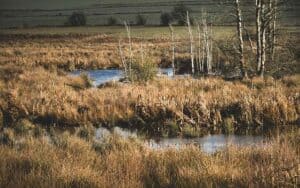
Wetlands are areas where the land is saturated or covered by water for extended periods, permanently or seasonally. They play a crucial role in the environment and provide various benefits. Here’s a brief definition and the importance of wetlands:
Wetlands are transitional zones between terrestrial and aquatic ecosystems. Waterlogged soils, diverse vegetation, and unique hydrological conditions characterize wetlands.
Importance
Wetlands are essential for several reasons:
Biodiversity
Wetlands support various plant and animal species, including specialized and rare ones. They provide habitat for waterfowl, fish, amphibians, and numerous other wildlife.
Water Regulation
Wetlands help regulate water flow and prevent flooding by absorbing and storing excess water during heavy rainfall. They act as natural sponges, reducing the impact of storms and preventing downstream flooding.
Water Filtration
Wetlands act as natural filters, purifying water by trapping sediments and pollutants. They improve water quality by removing excess nutrients and chemicals.
Carbon Storage
Wetlands are significant carbon sinks, storing large amounts of organic matter. They play a vital role in mitigating climate change by capturing and storing atmospheric carbon dioxide.
Recreation and Tourism
Wetlands provide recreational opportunities like birdwatching, boating, and nature walks. They attract tourists and contribute to local economies.
Types of wetlands
Wetlands can be classified into several types based on physical and ecological characteristics. Here are some common types of wetlands:
Marshes
Marshes are wetlands characterized by shallow water and herbaceous vegetation. They are often found along the edges of rivers, lakes, or coastal areas. Marshes support grasses, reeds, and various wetland plants.
Swamps
Swamps are wetlands dominated by trees, shrubs, and other woody vegetation. They occur in low-lying areas and are typically associated with slow-moving or stagnant water. Swamps can be freshwater or saltwater, depending on their location.
Bogs
Bogs are wetlands with acidic and nutrient-poor conditions. They are typically fed by rainfall and are characterized by the accumulation of organic material known as peat. Bogs are often home to unique species like sphagnum moss and carnivorous plants.
Fens
Fens are wetlands similar to bogs but with a higher nutrient content. They receive water from surface and groundwater sources, resulting in higher mineral content. Fens support diverse vegetation, including sedges, grasses, and mosses.
Each type of wetland has its distinct characteristics, hydrology, and plant and animal communities, contributing to the overall diversity and ecological significance of wetland ecosystems.
Deserts and Xeric Shrublands
Desert ecosystems are characterized by extreme aridity, limited rainfall, and sparse vegetation. Despite the harsh conditions, deserts are home to a surprising diversity of life. Here are some critical characteristics of desert ecosystems:
Aridity
Deserts are defined by their arid climate, with meager annual precipitation. They often experience high temperatures during the day and significant temperature fluctuations between day and night.
Water Scarcity
Water is scarce in deserts, and plants and animals have adapted to survive with limited water availability. Desert organisms have evolved mechanisms to conserve water, such as reducing water loss through specialized leaves or storing water in their tissues.
Adaptations
Desert plants and animals have unique adaptations to cope with the harsh environment. These include drought tolerance, water storage capabilities, efficient water and energy use, and specialized anatomical features like spines, thorns, and thick waxy coatings.
Biodiversity
Deserts support a surprising amount of biodiversity, including various plant species, insects, reptiles, mammals, and birds. Many desert species have evolved specific adaptations to survive extreme temperatures and rely on specialized behaviors to find food and water.
Types of Deserts
Deserts can be classified into different types based on geographical location, climate, and specific characteristics. Here are some common types of deserts:
Hot Deserts
Hot deserts are characterized by high temperatures throughout the year.
These deserts are commonly found in tropical and subtropical regions, such as Africa’s Sahara Desert or North America’s Mojave Desert.
Cold Deserts
Cold deserts experience low temperatures, particularly during the winter season. Cold deserts are found in higher altitudes or latitudes like Asia’s Gobi Desert or South America’s Patagonia desert.
Xeric Shrublands
Xeric shrublands, also known as desert shrublands or semi-deserts, are transitional areas between deserts and more fertile regions. They have slightly higher rainfall than true deserts, allowing drought-tolerant shrubs and other xerophytic vegetation to grow.
Xeric shrublands and Their Adaptations
As transitional zones between deserts and more favorable environments, Xeric shrublands have unique adaptations and characteristics. Here are some notable points:
- Xeric shrublands have vegetation dominated by drought-resistant shrubs, small trees, and xerophytic plants adapted to survive in arid conditions.
- These ecosystems often mix desert-adapted species and species that can tolerate slightly higher moisture levels.
- Xeric shrublands typically exhibit adaptations such as deep root systems, water-storing tissues, reduced leaf surface area, and specialized physiological and reproductive strategies to withstand prolonged dry periods.
- Some common plant species found in xeric shrublands include cacti, succulents, desert shrubs, and grasses that can thrive in semi-arid environments.
Each type of desert ecosystem, including hot deserts, cold deserts, and xeric shrublands, has distinct characteristics, plant and animal adaptations, and ecological dynamics.
Tundra and Arctic Ecosystems
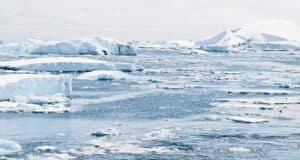
Tundra ecosystems are found in the Arctic and some high-altitude regions, characterized by freezing temperatures, a short growing season, and a lack of trees. Here are some key features of tundra ecosystems:
Cold Climate
Tundras experience long, cold winters and short, cool summers. Average temperatures remain below freezing for most of the year, limiting plant growth and biological activity.
Permafrost
Permafrost is a permanently frozen soil layer beneath the tundra’s surface. It restricts plant roots’ penetration and influences the ecosystem’s hydrological processes.
Low Biodiversity
Tundras have relatively low biodiversity compared to other ecosystems. The harsh climate, limited plant growth, and short growing season contribute to the presence of specialized and hardy species adapted to survive in these conditions.
Vegetation
Low-lying plants, such as mosses, small shrubs, lichens and grasses consist the vegetation of Tundra. Trees are primarily absent due to the cold temperatures and shallow permafrost.
Adaptations of plants and animals in the tundra
Plants and animals in the tundra have evolved unique adaptations to cope with extreme cold and challenging conditions. Here are some notable adaptations:
Plant Adaptations
Plants adopt unique characteristics to survive in Tundra these are:
Low Growth
Tundra plants grow close to the ground to minimize exposure to harsh winds and retain heat from the ground.
Shallow Root Systems
The permafrost restricts the depth to which plants can grow their roots. Many tundra plants have shallow root systems to access nutrients in the upper layers of soil.
Cushion Growth Forms
Some plants, like cushion plants, grow in compact, low-lying forms that help them retain heat and protect against wind.
Animal Adaptations
Likewise animals in Tundra adopt certain adoptions to survive.
Insulation
Many tundra animals have thick fur or feathers that provide insulation against the cold. This helps them conserve body heat in freezing temperatures.
Migration
Some animals, such as caribou and birds, migrate long-distance to find food and suitable breeding grounds during the short summer.
Hibernation
Certain tundra animals, like bears, undergo hibernation to conserve energy and survive the winter when food is scarce.
Threats to Tundra Ecosystems
Tundra ecosystems face various threats that can disrupt their delicate balance and unique characteristics. Here are some significant threats to tundra ecosystems:
Climate Change
Tundras are highly vulnerable to climate change. As temperatures rise, permafrost has the potential to thaw, leading to transformations in the landscape and the release of stored carbon into the atmosphere. It can also disrupt the timing of plant and animal life cycles.
Human Activities
Human activities like oil and gas exploration, infrastructure development, and mining can directly impact tundra ecosystems. They can lead to habitat destruction, pollution, and disturbance of wildlife.
Overgrazing
Excessive grazing by introduced herbivores can disrupt the delicate vegetation balance in tundra ecosystems. Overgrazing can lead to soil erosion, reduced plant cover, and changes in plant community composition.
Pollution
Pollution from industrial activities and long-range transport can contaminate tundra environments. Pollutants can accumulate in the food chain, posing risks to plant and animal species.
Preserving tundra ecosystems is crucial to maintaining their unique biodiversity and the ecological services they provide. Conservation efforts, sustainable land use practices, and addressing climate change are essential for protecting these delicate and fragile environments.
Marine and Coastal Ecosystems
Marine and costal ecosystems are vital ecosystems on our planet
Importance of Marine and Coastal Ecosystems
Marine and coastal ecosystems are vital components of the Earth’s biodiversity, providing numerous benefits to the environment and human populations. Here’s an explanation of their importance:
Biodiversity
Marine and coastal ecosystems support a wide variety of plant and animal species. Coral reefs, seagrass beds, mangroves, and other habitats offer shelter, feeding grounds, and breeding sites for countless marine organisms, contributing to rich biodiversity.
Fisheries
These ecosystems play a vital role in supporting the fishing industry and serve as a crucial food source for millions of people worldwide. Healthy marine habitats sustain fish populations, supporting the livelihoods of fishing communities.
Climate Regulation
Oceans play a vital role in regulating the Earth’s climate. They absorb a substantial amount of carbon dioxide, helping mitigate climate change’s impacts. Additionally, coastal wetlands and mangroves act as carbon sinks, storing carbon and reducing greenhouse gas emissions.
Coastal Protection
Mangroves, seagrass beds, and coral reefs act as natural buffers, protecting coastlines from erosion and the destructive forces of storms and waves. They serve as a frontline defense against coastal erosion and mitigate the impacts of tsunamis and storm surges.
Tourism and Recreation
Coastal regions are attractions for tourists, offering abundant opportunities for recreational activities like swimming, snorkeling, and diving. Among these attractions, coral reefs stand out as highly sought-after destinations for ecotourism, making significant contributions to local economies.
Coral Reefs and Their Significance
Coral reefs are diverse and vibrant marine ecosystems built by coral polyps, tiny organisms that secrete calcium carbonate to form hard skeletons. Here’s why coral reefs are significant:
Biodiversity Hotspots
Coral reefs are incredibly diverse ecosystems and are considered one of the most biodiverse habitats on the planet. They provide a home for a wide variety of marine organism species, including fish, invertebrates, and plants.
Their vibrant colors and unique marine life attract divers and snorkelers worldwide.
Fisheries and Food Security
Many fish species rely on coral reefs for shelter and food, making them essential for fisheries and ensuring food security for coastal communities.
Coastal Protection
Coral reefs act as natural barriers, protecting coastlines from wave erosion and storm damage. They absorb the energy of waves, reducing their impact on the shore.
Medicinal Properties
Coral reefs are a potential source of new medicines, as some marine organisms found in reefs have shown promise in pharmaceutical research.
Tourism and Economy
Coral reefs support a thriving tourism industry, generating income and employment opportunities for communities near reef systems.
Mangroves and Seagrass Beds
Mangroves and seagrass beds are critical coastal habitats that offer a range of ecological benefits:
Nursery Habitats
Mangroves and seagrass beds serve as nursery areas for juvenile fish and other marine species, providing protection and food sources during their early life stages.
Erosion Control
Mangroves have extensive root systems that stabilize shorelines and protect coastal areas from erosion caused by waves and tides.
Water Quality
Both mangroves and seagrass beds filter and purify water, removing pollutants and excess nutrients from runoff before they reach the ocean.
Carbon Sequestration
Mangroves and seagrass beds are highly efficient at capturing and storing carbon dioxide, making them valuable assets in the fight against climate change.
Biodiversity Support
These habitats provide habitat for a wide range of marine life, including birds, crustaceans, and various fish species.
Conservation and sustainable management of marine and coastal ecosystems are crucial to safeguarding their numerous benefits to the environment, economies, and human well-being.
Endangered Species
Endangered species are organisms that face a high risk of extinction in the near future. They are typically characterized by a decline in population size, loss of habitat, or other factors threatening their survival.
The criteria for categorizing a species as endangered may vary depending on the specific classification system, but here are some common factors considered:
Population Size
Endangered species often have a small population size, making them vulnerable to various threats and reducing their genetic diversity.
Habitat Loss and Fragmentation to Endanger Species
Destruction, degradation, or fragmentation of their natural habitat significantly impacts endangered species, limiting their ability to find food, mates, and suitable conditions for survival.
Overexploitation
Unsustainable hunting, fishing, or trade can bring species to extinction. Illegal wildlife trade and poaching pose significant threats to many endangered species.
Climate Change
Alterations in temperature, precipitation patterns, and sea-level rise due to climate change can adversely affect endangered species’ habitats and life cycles, making them more vulnerable to extinction.
Examples of Endangered Species and Their Conservation Status
Numerous species across the globe are currently classified as endangered. Here are some examples of endangered species and their conservation status:
Sumatran Orangutan (Pongo abelii): Critically Endangered, habitat loss, illegal hunting, and the palm oil industry have drastically reduced their populations.
African Elephant (Loxodonta africana): Endangered, poaching for ivory, and habitat loss are significant threats to these majestic creatures.
Hawksbill Sea Turtle (Eretmochelys imbricata): Critically Endangered. Overexploitation of their shells, destruction of nesting beaches, and marine pollution pose severe risks to their survival.
Sumatran Tiger (Panthera tigris sumatrae): Critically Endangered. Habitat loss, illegal hunting, and poaching have driven this subspecies to the brink of extinction.
Conservation Efforts and Success Stories
Conservation efforts are vital in saving endangered species and reversing their decline. Here are some examples of conservation efforts and success stories:
Protected Areas
Establishing and effectively managing protected areas, such as national parks and wildlife reserves, help safeguard the habitats of endangered species. These areas provide safe havens where species can thrive and reproduce.
Habitat Restoration
Efforts to restore and rehabilitate degraded habitats can create suitable environments for endangered species to recover. Restoration activities may include reforestation, wetland restoration, or coral reef rehabilitation.
Anti-Poaching Measures
Strict law enforcement, anti-poaching patrols, and raising awareness about the consequences of illegal wildlife trade are crucial in protecting endangered species from poaching and exploitation.
International Cooperation
Collaborative efforts between countries, organizations, and communities are essential for addressing cross-border issues and implementing conservation strategies on a global scale.
Breeding Programs
Captive breeding programs, such as those for pandas or condors, have successfully increased the populations of critically endangered species and reintroduced them to the wild.
While progress has been made in conserving endangered species, many challenges remain. Continued efforts in habitat protection, wildlife management, and addressing the underlying causes of species decline are necessary to ensure the long-term survival of endangered species and promote global biodiversity conservation.
Conservation Strategies
Protected areas and national parks are essential conservation strategies that safeguard natural habitats and biodiversity. Here’s an explanation of their significance:
Conservation of Biodiversity
Protected areas and national parks serve as havens for various plant and animal species. By designating specific areas for protection, these strategies help preserve the diversity of life and maintain healthy ecosystems.
Habitat Protection
These areas provide refuge and protection for endangered species, allowing them to thrive without the threats posed by habitat destruction, hunting, or other human activities.
Scientific Research and Education
Protected areas and national parks facilitate scientific research, enabling experts to study ecosystems, monitor species populations, and develop conservation strategies. They also serve as educational sites, promoting public awareness and appreciation of nature.
Sustainable Tourism
Many protected areas and national parks are open to visitors, offering opportunities for sustainable tourism. This generates income that can be used for conservation efforts while providing educational and recreational experiences for visitors.
Wildlife Corridors and Habitat Restoration
Wildlife corridors and habitat restoration initiatives are vital for maintaining ecological connectivity and rehabilitating degraded habitats. Here’s an explanation of their role in conservation:
Ecological Connectivity
Wildlife corridors are strips of habitat that connect fragmented areas, allowing wildlife to move between regions. They facilitate the migration of animals, gene flow, and the recolonization of suitable habitats, contributing to species’ long-term survival.
Mitigating Habitat Fragmentation
Habitat fragmentation caused by human activities can disrupt ecological processes and isolate populations, increasing the risk of local extinction. Wildlife corridors help counteract the negative impacts of fragmentation by providing connectivity and promoting genetic diversity.
Habitat Restoration
Habitat restoration involves repairing or rehabilitating degraded ecosystems. It aims to bring back native vegetation, improve water quality, and enhance biodiversity.
Restoration efforts can include reforestation, wetland rehabilitation, or removing invasive species to restore the natural balance of ecosystems.
Sustainable Land Use
Incorporating wildlife corridors and habitat restoration into land-use planning promotes sustainable practices that balance conservation and human activities. It allows for the coexistence of communities and wildlife, minimizing conflicts while preserving natural habitats.
Sustainable Development and Community Involvement
Conservation strategies prioritizing sustainable development and involving local communities are crucial for long-term success. Here’s how they contribute to conservation efforts:
Balancing Conservation and Development
Sustainable development seeks to meet the needs of present and future generations while conserving the environment. It involves responsible land use, resource management, and minimizing the ecological footprint of human activities.
Community Involvement
Engaging local communities in conservation efforts fosters a sense of ownership and responsibility. It recognizes their traditional knowledge, promotes sustainable livelihoods, and ensures conservation initiatives align with local needs and aspirations.
Environmental Education and Awareness
Promoting environmental education and raising awareness about the importance of conservation within communities fosters a culture of environmental stewardship. It helps people understand the value of natural resources and encourages sustainable practices.
Sustainable Livelihoods
Integrating conservation goals with sustainable livelihood opportunities, such as ecotourism or sustainable agriculture, provides economic incentives for communities to support conservation efforts. It ensures that local communities benefit from protecting natural resources.
Comprehensive conservation strategies can effectively preserve biodiversity, restore ecosystems, and promote sustainable coexistence between humans and nature by combining protected areas, wildlife corridors, habitat restoration, sustainable development, and community involvement.
Implementing these strategies may vary depending on each region or project’s specific context and conservation goals.
Benefits of Ecotourism
Economic and ecological benefits of ecotourism:
Ecotourism, a form of sustainable tourism focusing on nature and conservation, offers several benefits for local communities and the environment.
Economic Benefits
Job Creation: Ecotourism creates employment opportunities, particularly in rural and remote areas where other economic activities may be limited. It generates jobs in various sectors, such as guiding, hospitality, transportation, and crafts.
Local Revenue: Ecotourism contributes to the local economy by generating income through visitor spending on accommodations, food, transportation, and souvenirs. This revenue can be reinvested in community development and conservation initiatives.
Diversification of Income: Communities that engage in ecotourism can diversify their sources of income, reducing their dependence on unsustainable activities such as logging or poaching.
Ecological Benefits
Conservation Funding: Ecotourism revenue can be directed toward protecting and managing natural areas. Funds can support conservation projects, habitat restoration, anti-poaching efforts, and the establishment of protected areas.
Environmental Education: Ecotourism provides opportunities for visitors to learn about local ecosystems, wildlife, and conservation efforts. This educational component fosters environmental awareness and promotes a sense of responsibility towards nature.
Habitat Preservation: By attaching economic value to intact ecosystems, ecotourism incentivizes the conservation and preservation of natural habitats. It creates financial incentives for local communities to protect biodiversity and maintain the ecological balance.
Examples of Successful Ecotourism Initiatives
Several ecotourism initiatives worldwide have demonstrated positive outcomes for conservation and local communities. Some examples are:
Costa Rica: Costa Rica is renowned for its successful ecotourism practices. The country has established a network of national parks, private reserves, and eco-lodges that attract visitors interested in experiencing its rich biodiversity.
Ecotourism has significantly contributed to the country’s economy and has played a crucial role in conserving natural resources.
Namib-Naukluft National Park, Namibia: The Namib-Naukluft National Park is an ecotourism destination known for its desert landscapes, wildlife, and community involvement. Local communities run lodges, guide tours, and manage conservation initiatives.
The park’s success highlights the potential for ecotourism to empower local communities and support wildlife conservation.
Galapagos Islands, Ecuador: The Galapagos Islands have implemented strict regulations and sustainable tourism practices to preserve the archipelago’s unique biodiversity. Visitors must follow guidelines to minimize their impact on the delicate ecosystem.
Tourism revenue contributes to conservation efforts and supports research and monitoring programs.
Responsible Travel Practices
Responsible travel practices ensure that ecotourism remains sustainable and beneficial for the environment and local communities. Some fundamental principles of responsible travel:
- Minimize Environmental Impact
- Respect Wildlife and Habitat
- Observe animals from a safe distance.
- Follow designated trails.
- Avoid disturbing their natural behavior or habitats.
- Reduce Waste and Use Resources Wisely
- Practice proper waste management
- Minimize water usage
- Support accommodations that prioritize sustainability.
Support Local Communities:
Respect local culture and traditions. Learn about local customs, traditions, and etiquette, and be respectful in your interactions with local communities.
Choose Locally Owned Businesses
Support local businesses, accommodations, and guides to ensure economic benefits directly benefit the community.
Educate Yourself and Others
Learn about the Environment: Educate yourself about the destination’s biodiversity, conservation challenges, and local conservation initiatives.
Share Knowledge
Spread awareness about responsible travel practices and the importance of conservation among fellow travelers.
By embracing responsible travel practices, visitors can contribute to the long-term sustainability of ecotourism destinations, support local economies, and conserve natural areas.
It is notable that the success and impact of ecotourism initiatives may vary depending on the destination, management practices, and the involvement of local communities.
Major Environmental Organizations of the World
Numerous organizations worldwide are dedicated to the conservation of natural vegetation and wildlife. Some prominent organizations actively working in this field:
World Wildlife Fund (WWF)
The WWF is one of the largest and most well-known conservation organizations globally.
It focuses on protecting the world’s most ecologically important regions and endangered species.
The WWF’s initiatives include habitat conservation, sustainable development, protection of wildlife, and combating climate change.
Conservation International (CI)
CI aims to safeguard biodiversity by promoting sustainable practices and protecting ecosystems.
It collaborates with local communities, governments, and businesses to implement conservation programs.
CI’s work includes protecting forests and marine habitats and addressing environmental challenges through science-based solutions.
The Nature Conservancy (TNC)
TNC is committed to conserving lands and waters on a large scale, emphasizing the protection of critical habitats.
It collaborates with governments, communities, and businesses to achieve lasting conservation outcomes.
TNC’s focus areas include forests, oceans, freshwater systems, and sustainable agriculture.
BirdLife International
BirdLife International is dedicated to the conservation of birds and their habitats worldwide.
It works through a network of partner organizations in over 100 countries, conducting research, advocacy, and habitat restoration.
BirdLife International’s efforts contribute to the preservation of ecosystems and the protection of threatened bird species.
International Union for Conservation of Nature (IUCN)
The IUCN is a global organization that brings together governments, NGOs, and scientists to address conservation challenges.
It provides scientific expertise, assesses species’ conservation status, and promotes sustainable development practices.
The IUCN also maintains the IUCN Red List of Threatened Species, a comprehensive database of species at risk of extinction.
Rainforest Trust
Rainforest Trust focuses on protecting tropical rainforests and other threatened habitats worldwide.
It partners with local organizations and communities to establish protected areas and promote sustainable land use practices.
Rainforest Trust’s approach combines land acquisition, scientific research, and community engagement to ensure long-term conservation.
These organizations and many others play vital roles in advocating for protecting natural vegetation and wildlife. Through their efforts, they contribute to preserving biodiversity, mitigating habitat loss, promoting sustainable practices, and raising awareness about the importance of conservation.
Remember that these are just a few organizations. Numerous other organizations are working diligently to conserve these natural resources globally and locally.
Conclusion
Natural vegetation and wildlife conservation are of utmost importance for the well-being of our planet and future generations. The rich biodiversity and intricate ecosystems supported by natural vegetation play a vital role in maintaining a healthy environment.
From providing oxygen and sequestering carbon to preventing soil erosion and serving as a habitat for wildlife, natural vegetation is an integral part of the Earth’s ecological balance. However, these invaluable resources are under threat due to human activities and climate change.
We must take action and support conservation efforts to address this critical situation. We can make a difference by promoting sustainable practices, supporting organizations working toward conservation, and advocating for the protection of natural habitats.
Each of us has a role to play in preserving the beauty and diversity of our natural world. Together, let’s take a stand and ensure the conservation of vegetation and wildlife for a sustainable and thriving planet.
Our collective efforts today will secure a better future for generations to come.


